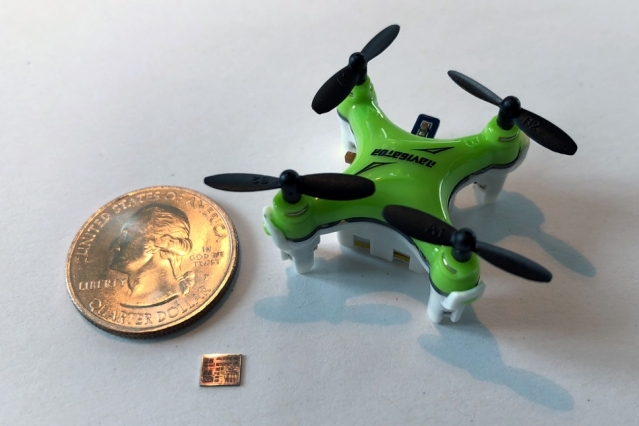Drones may get smaller and smarter with new MIT nano chip
Buzzing bug-sized bots

Drones already sound like bees, but MIT researchers reckon they can make drones as small as bees – ones that are smarter, smaller and fly for longer than our favorite quadcopters.
A team at MIT’s Department of Electrical Engineering and Computer Science has designed a computer chip, called Navion, that’s 20 square millimeters but consumes only 24 milliwatts of power. To put that into perspective, it’s the size of a Lego figure’s footprint consuming one thousand times less than your average lightbulb.
This is the second attempt at the concept. The team initially designed the chip last year and, although it was small enough to power miniature drones, it used two watts of power. Instead of tweaking the existing design, however, the team built the chip from the ground up.

Small is big
According to MIT News, the chip can process camera images at up to 171 frames per second and calculate inertial measurements in real time, and uses both bits of information to figure out it’s location.
While it’s processing power sounds impressive, the team designed the chip so that it minimized the amount of data stored at any given time while also optimizing the way data flows across the chip.
“Any of the images we would’ve temporarily stored on the chip, we actually compressed so it required less memory,” says Vivienne Sze, co-lead on the Navion project.
Another way the team was able to reduce power consumption was to reduce mathematical calculations the chip needed to perform, like removing all computations involving zero as the answer is always zero.
Sign up for breaking news, reviews, opinion, top tech deals, and more.
Size does matter
The new chip, say the researchers, can be used in “nanodrones” that are “as small as a fingernail” and help navigate them, especially in remote areas where GPS signals are usually intermittent or completely inaccessible.
With the chip’s energy-saving capabilities, the bug-sized bots could also have a longer flight time than the quadcopters we have today.
You won’t be seeing these tiny drones buzzing around any time soon, though. The researchers are planning on testing this proof-of-concept in a miniature race car first, one that carries an on-board camera that’s able to stream live video. Integrating the chip into drones will follow after.
[Via MIT News]

While she's happiest with a camera in her hand, Sharmishta's main priority is being TechRadar's APAC Managing Editor, looking after the day-to-day functioning of the Australian, New Zealand and Singapore editions of the site, steering everything from news and reviews to ecommerce content like deals and coupon codes. While she loves reviewing cameras and lenses when she can, she's also an avid reader and has become quite the expert on ereaders and E Ink writing tablets, having appeared on Singaporean radio to talk about these underrated devices. Other than her duties at TechRadar, she's also the Managing Editor of the Australian edition of Digital Camera World, and writes for Tom's Guide and T3.